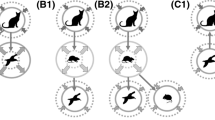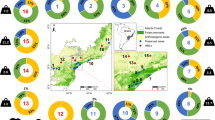Abstract
At the Prince Edward Islands, temperatures have increased by approximately 1°C over the past 40 years, accompanied by a decline in precipitation. This has led to a reduction in the peat moisture content of mires and higher growing season “warmth”. The temperature-and moisture-sensitive sedge, Uncinia compacta R. Br. (Cyperaceae), has consequently increased its aerial cover on Prince Edward Island, but harvesting of seeds by feral house mice (up to 100% removed) has prevented this from happening on Marion Island. Such extensive use of resources suggests that prey switching may be taking place at Marion Island. Scat analyses revealed that mice are·not only eating ectemnorhinine weevils to a greater extent than found in previous studies of populations at Marion Island, but that they also prefer larger weevils (±6 mm). A decrease in body size of preferred weevil prey species [Bothrometopus randi Jeannel and Ectemnorhinus similis C.O. Waterhouse (Coleoptera: Curculionidae)] has taken place on Marion Island (1986–1992), but not on Prince Edward Island. This appears to be a result of increased predation on weevils. In addition, adults of the prey species, E. similis are relatively more abundant on Prince Edward Island than adults of the smaller congener E. marioni Jeannel, and could not be found on Marion Island in the late austral summer of 1991. These results not only provide support for previous hypotheses of the effect of global warming on mouse-plant-invertebrate interactions on the Prince Edward Islands, but also provide limited evidence for the first recorded case of predator-mediated speciation. They also show that the interaction of human-induced changes operating at different scales may have profound consequences for local systems.
Similar content being viewed by others
References
Adamson DA, Whetton P, Selkirk PM (1988) An analysis of air temperature records for Macquarie Island: Decadal warming, ENSO cooling and southern hemisphere circulation patterns. Pap Proc R Soc Tasmania 122: 107–112
Allison IF, Keague PL (1986) Recent changes in the glaciers of Heard Island. Polar Rec 23:255–271
Bush GL (1975) Modes of animal speciation. Annu Rev Ecol Syst 6:339–364
Calder WA (1984) Size, function and life history. Harvard University Press, Cambridge
Chown SL (1989a) Habitat use and diet as biogeographic indicators for subantarctic Ectemnorhinini (Coleoptera: Curculionidae). Antarct Sci 1:23–30
Chown SL (1989b) Ecology and Systematics of the Ectemnorhinini (Coleoptera: Curculionidae: Entiminae). PhD Dissertation, University of Pretoria
Chown SL (1990) Speciation in the sub-Antarctic weevil genus Dusmoecetes Jeannel (Coleoptera: Curculionidae). Syst Entomol 15:283–296
Chown SL, Scholtz CH (1989) Biology and ecology of the Dusmoecetes Jeannel (Col. Curculionidae) species complex on Marion Island. Oecologia 80:93–99
Cook E, Bird T, Peterson M, Barbetti M, Buckley B, D'Arrigo R, Francey R, Tans P (1991) Climatic change in Tasmania inferred from a 1089-year tree-ring chronology of Huon pine. Science 253:1266–1268
Crafford JE (1990a) Patterns of energy flow of the dominant insect consumers on Marion Island. PhD Dissertation, University of Pretoria
Crafford JE (1990b) The role of feral house mice in ecosystem functioning on Marion Island. In: Kerry KR, Hempel G (eds) Antarctic ecosystems: ecological change and conservation. Springer, Berlin, pp 359–364
Crafford JE, Scholtz CH (1987) Quantitative differences between the insect faunas of sub-Antarctic Marion and Prince Edward Islands: A result of human intervention? Biol Conserv 40:255–262
Dickman CR, Huang C (1988) The reliability of fecal analysis as a method for determining the diet of insectivorous mammals. J Mammal 69: 108–113
Enright JT (1976) Climate and population regulation: the biogeographers dilemma. Oecologia 24:295–310
Fleming TH (1979) Life-history strategies In: Stoddart DM (ed) Ecology of small mammals. Chapman and Hall, London, pp 1–61
Friis-Christensen E, Lassen K (1991) Length of the solar cycle: An indicator of solar activity closely associated with climate. Science 254:698–700
Futuyma DJ, Mayer GC (1980) Non-allopatric speciation in animals. Syst Zool 29:254–271
Gibbons JRH (1979) A model for sympatric speciation in Megarhyssa (Hymenoptera: Ichneumonidae): Competitive speciation. Am Nat 114:719–741
Gleeson JP (1981) The ecology of the house mouse, Mus musculus Linnaeus, on Marion Island. MSc Thesis, University of Pretoria
Gleeson JP, Van Rensburg PJJ (1982) Feeding ecology of the house mouse Mus musculus on Marion Island. S Afr J Antarct Res 12:34–39
Gremmen NJM (1981) The vegetation of the subantarctic islands Marion and Prince Edward. Junk, The Hague
Hansen J, Lebedeff S (1987) Global trends of measured surface air-temperature. J Geophys Res 92: 3345–3372
Hansson L (1970) Methods of morphological diet micro-analysis in rodents. Oikos 21: 255–266
Hansson L (1985) The food of bank voles, wood mice and yellow-necked mice. Symp Zool Soc Lond 55: 141–168
Holland EA, Parton WJ, Detling JK, Coppock DL (1992) Physiological responses of plant populations to herbivory and their consequences for ecosystem nutrient flow. Am Nat 140: 685–706
Holling CS (1959) The components of predation as revealed by a study of small-mammal predation of the European pine sawfly. Can Entomol 91: 293–320
Huntley BJ (1968) A floristic and ecological account of the vegetation of Marion and Prince Edward Islands, South Indian Ocean. M.Sc. Thesis, University of Pretoria
Huntley BJ (1971) Vegetation. In: Van Zinderen Bakker EM, Winterbottom JM, Dyer RA (eds) Marion and Prince Edward Islands. Report on the South African Biological and Geological Expedition 1965–1966. AA Balkema, Cape Town, pp 98–160
Kingsolver J (1989) Weather and the population dynamics of insects: Integrating physiological and population ecology. Physiol Zool 62: 314–334
Krebs JR, McCleery RH (1984) Optimization in behavioural ecology. In: Krebs JR, Davies NB (eds) Behavioural ecology: an evolutionary approach. Blackwell, Oxford, pp 91–121
Lacher TE, Willig MR, Mares MA (1982) Food preference as a function of resource abundance with multiple prey types: An experimental analysis of optimal foraging theory. Am Nat 120: 297–316
Murdoch WW, Oaten A (1975) Predation and population stability. Adv Ecol Res 9: 1–131
Otte D, Endler JA (1989) Speciation and its consequences. Sinauer, Sunderland
Park T (1954) Experimental studies of interspecies competition. II. Temperature, humidity, and competition in two species of Tribolium. Physiol Zool 27: 177–229
Peters RH (1983) The ecological implications of body size. Cambridge University Press, Cambridge
Pianka ER (1983) Evolutionary ecology, 3rd edn. Harper and Row, New York
Rowe-Rowe DT, Green B, Crafford JE (1989) Estimated impact of feral house mice on sub-Antarctic invertebrates at Marion Island. Polar Biol 9: 457–460
Smith VR (1976) Standing crop and nutrient status of Marion Island (sub-Antarctic) vegetation. J S Afr Bot 42: 231–263
Smith VR (1987a) The environment and biota of Marion Island. S Afr J Sci 83: 211–220
Smith VR (1987b) Seasonal changes in plant and soil chemical composition at Marion Island (sub-Antarctic): I-Mire grasslands. S Afr J Antarct Res 17: 117–132
Smith VR, Steenkamp M (1990) Climatic change and its ecological implications at a subantarctic island. Oecologia 85: 14–24
Smith VR, Steenkamp M (1992a) Soil macrofauna and nitrogen on a sub-Antarctic Island. Oecologia 92: 201–206
Smith VR, Steenkamp M (1992b) Soil nitrogen transformation on a sub-Antarctic Island. Antarct Sci 4: 41–50
Steenkamp M (1991) Decomposition and nutrient mineralization on sub-Antarctic Marion Island. Ph.D. Dissertation, University of the Orange Free State
Theodorides J, Chown SL (1992) On the occurrence of Gregarina munieri (A. Schneider) (Apicomplexa, Eugregarina, Gregarinidae) in weevils (Coleoptera, Curculionidae) from Marion Island. Bull Soc Parasitol Fr 10: 27–29
Van Zinderen Bakker EM, Winterbottom JM, Dyer RA (eds) (1971) Marion and Prince Edward Islands. Report on the South African Biological and Geological Expedition 1965–1966. AA Balkema, Cape Town
Author information
Authors and Affiliations
Rights and permissions
About this article
Cite this article
Chown, S.L., Smith, V.R. Climate change and the short-term impact of feral house mice at the sub-Antarctic Prince Edward Islands. Oecologia 96, 508–516 (1993). https://doi.org/10.1007/BF00320508
Received:
Accepted:
Issue Date:
DOI: https://doi.org/10.1007/BF00320508




